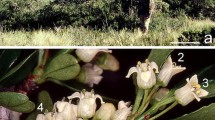Abstract
Eupatorium is a large, chiefly American genus in which some species have deviated from the usual reproductive methods of insect pollination and outcrossing. Apomixis and autogamy are two reproductive specializations which have been reported previously. A third, anemophily, is suspected inE. solidaginifolium, E. solidaginoides, E. monanthum, and several other species. Our assumptions are based upon morphological modifications of the inflorescence, anther appendages, style branches, and pollen. Wind pollination in the Compositae has heretofore been known only in the tribe Anthemideae and the subtribe Ambrosinae of the Heliantheae; its occurrence inEupatorium is an independent evolutionary event. The occurrence of apomixis, autogamy, and anemophily in members ofEupatorium from the same geographical region probably represents (at least in part) correlated responses to the same environmental stress, a scarcity of insect pollinators.
Similar content being viewed by others
Literature Cited
Baker, H. G. 1965. Characteristics and modes of origin of weeds. pp. 147–172.In: Baker, H. G. & G. L. Stebbins, Jr. (Editors) The Genetics of Colonizing Species. New York & London: Academic Press. xv + 588 pp.
— 1967. The evolution of weedy taxa in theEupatorium microstemon species aggregate. Taxon16: 293–300.
Bianchi, D. E., D. J. Schwemmin, &W. H. Wagner, Jr. 1959. Pollen release in the common ragweed (Ambrosia artemisiifolia). Bot. Gaz.120: 235–243.
Cronquist, A. 1955. Phylogeny and taxonomy of the Compositae. Amer. Midl. Nat.53: 478–511.
Cross, Laura B. 1897. On the structure and pollination of the flowers ofEupatorium ageratoides andE. coelestinum. Contr. Bot. Lab. Morris Arboretum, Univ. Pennsylvania1: 260–269.
Faegri, K. &L. van der Pijl 1966. The Principles of Pollination Ecology. New York & London: Pergamon Press. ix + 248 pp.
Fries, R. E. 1903. BeitrÄge zur Kenntnis der Ornithophilie in der südamerikanischen Flora. Arkiv för Bot. (Stockholm)1: 389–440.
Grashoff, J. L. 1969. Reproductive processes affecting the taxonomy of some Mexican and Central American species ofEupatorium. Thesis: Master’s Degree. Michigan State Univ. 101 pp.
Holmgren, J. 1919. Zytologische Studien über die Fortpflanzung bei den GattungenErigeron undEupatorium. Kongl. Svenska Vetenskapsakad. Handl.59(7): 1–72.
Knuth, P. 1906–1909. Handbook of Flower Pollination. 3 vols. (Translation by J. R. Ainsworth Davis) Oxford, England: Clarendon Press. Vol. I. Introduction and Literature. xix + 382 pp. 1906; Vol. II. Ranunculaceae to Stylidieae. viii + 703 pp. 1908; Vol. III. Goodenovieae to Cycadeae. 644 pp. 1909.
Payne, W. W. 1963. The morphology of the inflorescence of ragweeds (Ambrosia-Franseria: Compositae). Amer. Jour. Bot.50: 872–880.
Robinson, B. L. 1926.Eupatorium.In: Standley, P. C., Trees and Shrubs of Mexico. Contr. U. S. Nat. Herb.23 (5): 1432–1469.
— 1928. Records preliminary to a general treatment of the Eupatorieae. VII. Contr. Gray Herb. (Harvard Univ.)80: 3–42.
Small, J. 1915. The pollen-presentation mechanism in the Compositae. Ann. Bot. (London)29: 457–470.
Sparvoli, E. 1960. Osservazioni cito-embriologiche inEupatorium riparium Reg.—Nota II: Megasporogenesi e sviluppo del gametofito feminile. Annali Bot. (Rome)26: 481–504.
Whitehead, D. R. 1969. Wind pollination in the angiosperms: Evolutionary and environmental considerations. Evolution23: 28–35.
Wodehouse, R. P. 1926. Pollen grain morphology in the classification of the Anthemideae. Bull. Torrey Bot. Club53: 479–485.
Author information
Authors and Affiliations
Additional information
A portion of a thesis submitted by the first author in partial fulfillment for the degree of Master of Science at Michigan State University.
Rights and permissions
About this article
Cite this article
Grashoff, J.L., Beaman, J.H. Studies in eupatorium (Compositae), III. Apparent wind pollination. Brittonia 22, 77–84 (1970). https://doi.org/10.2307/2805722
Published:
Issue Date:
DOI: https://doi.org/10.2307/2805722




